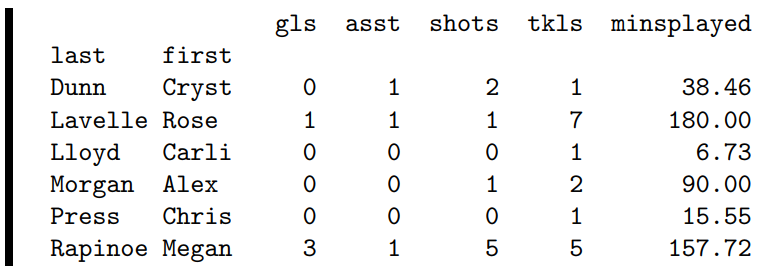24.2: Transforming with Simple Operations
- Page ID
- 88751
Now that we’ve converted the awkward minutes-and-seconds columns to just “time” columns, all we need to do to complete our analysis is transform this data by computing a new quantity entirely: the total number of minutes played for each player in each game. Again, Pandas makes this easy:
Code \(\PageIndex{1}\) (Python):
wc['minsplayed'] = wc.outtime - wc.intime
print(wc)

Voilà. We now have the time-on-field for each player, which gives us a whole new avenue of exploration. For example, any of the counting stats (goals, assists, etc.) can be converted into a “perminute” version, showing us how productive a player was while on the field. Let’s do that for tkls (“tackles”), and multiply by 90 to obtain a “tackles-per-90-minutes” statistic1 :
Code \(\PageIndex{2}\) (Python):
wc['minsplayed'] = wc['outtime'] - wc['intime']
wc['tkl_per_90'] = np.round(wc['tkls'] /
wc['minsplayed'] * 90,2)
del wc['tkls']

Transforming Grouped Data
The above example computed tackles-per-game all right, but it still left us with one row for every player-performance. (In other words, the results had two rows for Rose Lavelle, one giving her tkl_per_90 for the June 28th game, and one giving it for the July 7th game.)
We might instead be interested in a player-by-player analysis: overall in the entire month-long World Cup, which players had the most tackles-per-game? This is easy to do with the .groupby() method that we first encountered in section 18.2 (p. 189). First, we group the rows by the first two columns (since first-and-last-namestogether are needed to uniquely identify a single player):
Code \(\PageIndex{3}\) (Python):
grouped_wc = wc.groupby(['last','first'])
We then take our new, temporary grouped_wc variable and extract the gls, asst, shots, tkls, and minsplayed columns from it, summing each of them to produce the per-player values in the result:
Code \(\PageIndex{4}\) (Python):
by_player = grouped_wc.sum()
This yields:

Now, we’re ready to compute a per-game analysis as before, but this time for each player’s entire World Cup games:
Code \(\PageIndex{5}\) (Python):
by_player['tkl_per_90'] = (np.round(by_player['tkls'] / by_player['minsplayed'] * 90,2))
del by_player['tkls']
1I’m choosing 90 minutes here because that’s how long a regulation-length soccer match is. Therefore, our new tkl_per_90 column gives us “numberof-tackles-per-complete-game,” which is easier to interpret than “tackles-per-minute,” which would be a miniscule number for any player.


